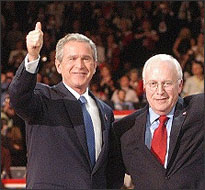
Television ratings for both the Democratic National Convention and Republican National Convention fell by half from 1960 to 2004, according to a Nielsen analysis. And though there are more networks now carrying coverage, the average number of hours devoted to the conventions has been trimmed substantially in recent decades. But the historic and competitive 2008 election saw a huge surge in viewership for both the DNC and the RNC events, and Barack Obama and John McCain drew high ratings for their speeches.
The last night of the 2012 RNC, when Mitt Romney accepted the nomination, saw a decline in ratings — an estimated 30.3 million viewers tuned in, compared to 38.9 million in 2008, according to Nielsen. Likewise, the Pew Research Center survey found that just 37% of the public watched some or all of the 2012 RNC, versus 56% in 2008. There was also a decline in viewership, albeit less dramatic, for the 2012 DNC; some 35.7 million viewers tuned in to see President Obama speak in 2012, compared to 38.4 million in 2008.
As the Pew Research Center also notes, the conventions are often the starting point for wider public interest in the campaigns. Political scientists have studied how conventions shape party unity and the framing of issues, as well as how public opinion can shift with regard to individual candidates. This is often reflected in the proverbial convention “bounce” or “bump” sometimes seen in poll numbers (on that, also see this political science analysis; and see this analysis from a polling perspective). Indeed, in 2008 both presidential candidates saw a post-convention bump, though there is caution about how long-lasting such effects typically are. In 2012, some political scientists expect only a small bump generally for either side.
Though a CNN/ORC International survey suggests that Romney saw a 1-point positive bounce, polling from Gallup suggests that Romney did not. Gallup notes that Romney is the first recent Republican nominee not to see a bounce; and he joins the ranks of Sen. John Kerry and George McGovern as the only nominees of either party not to register a bounce since Gallup began tracking this data in 1964. President Obama, by contrast, did enjoy a post-2012 DNC bounce of several points, according to most polls.
Exactly which members of the public — partisans and party members, independents or undecided voters — are typically persuaded by the substance, and theater, of conventions is the subject of new research. A 2012 study in American Politics Research, “The Individual-Level Effects of Presidential Conventions on Candidate Evaluations,” examined how the 2004 Democratic and Republican Party conventions influenced individual voters’ perceptions of presidential candidates John Kerry and George W. Bush. The researchers, at the University of Wisconsin-Milwaukee, used data from the 2004 National Annenberg Election Study, which involved paired interviews of 630 Democratic, Republican and unaffiliated voters conducted within 11 days before and after each convention. The researchers distinguished between voluntary exposure to convention content, such as watching the speeches, and involuntary exposure, including ambient news and cultural coverage of the events, to better isolate the impacts of each.
Study findings include:
- “Party affiliation influences the initial decision to expose oneself to convention speeches (and, by extension, to the opportunity to be persuaded), but partisanship does not appear to regularly condition the persuasive impact of speech consumption on postconvention candidate evaluations.”
- Partisans were more than twice as likely to watch important convention speeches by representatives of their own political party than were independents or partisans of the opposing party. “Independents were the least likely to watch the speeches in their entirety, a finding consistent with decades of research indicating that those without partisan affiliation are the least likely to pay attention to campaigns.”
- Watching convention speeches consistently improved the ratings of the convention candidate’s positive traits and reduced those of the opposition candidate.
- Both candidates received a “bump” in approval ratings after their conventions, mainly from their partisan supporters. “Conventions appear to be times when the parties, through brute-force media saturation, maximize their roles as social-psychological group rallying points. The easy accessibility of partisan affiliation during conventions allows partisanship an increased role in individual-level judgment of candidate traits.”
- Candidates also received higher approval ratings from independents and unaffiliated voters after each convention, suggesting that “independents, although only a small part of the electorate, are exceptionally persuadable.”
- However, higher post-convention favorability ratings for a candidate were counterbalanced by the activation of partisan bias from supporters of the opposition candidate.
The researchers conclude that the effects of conventions are quite complex when individual citizens’ responses are considered. Though aggregate poll numbers may surge, beneath the surface of the polls there is a mix of feelings swirling: conventions stir up partisan bias among parts of the electorate, even as they increase positive evaluations of candidates among other voters.
A related 2012 study by the same scholars, “The Conditional Effects of Competing Messages during Presidential Nominating Conventions,” examines the complex interaction between the sequence of messages from the Democratic and Republican conventions, and their effects over time. The study, published in Presidential Studies Quarterly, concludes that “candidates would be well served by making the most of opportunities to make direct positive impressions on the electorate. Such impressions appear to be enduring and surprisingly resilient against competing negative messaging.”
Also of interest is “The Strategic Importance of State-Level Factors in Presidential Elections,” published in 2004 in the journal Publius. It concludes that “generally, parties do not derive significant electoral benefits in states selected to host the national convention,” though “important differences are found over time and between the two political parties.”
For data on the current presidential race, a 2012 Pew Research Center report puts evaluations and favorability ratings trends of Mitt Romney and Barack Obama in historical perspective.
Tags: campaigns and media, elections
